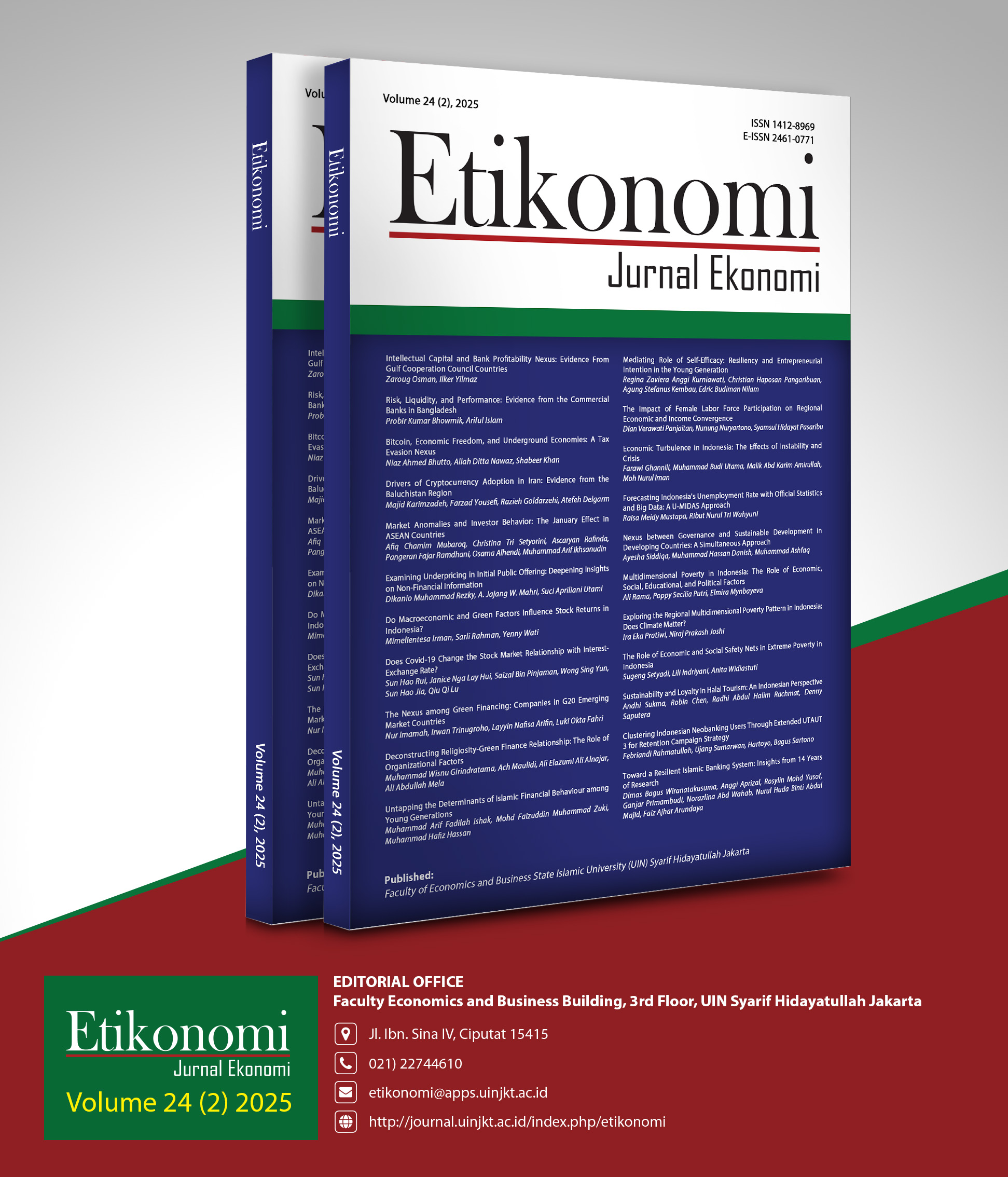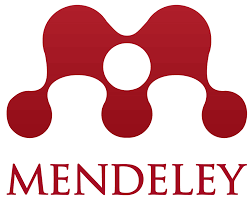Intellectual Capital and Bank Profitability Nexus: Evidence From Gulf Cooperation Council Countries
DOI:
https://doi.org/10.15408/etk.v24i2.38708Keywords:
Intellectual capital, bank profitability, GCC countriesAbstract
Research Originality: This article presents novel and fresh empirical evidence on the relationship between intellectual capital and bank profitability and reports the results for the whole sample as well as at country breakdown.
Research Objectives: Using a dataset of 60 banks from GCC countries between 2008 and 2022, the article investigates the association between intellectual capital and bank profitability by implementing M-VAIC.
Research Methods: We developed two models in which profitability ratios are the dependent variables and the M-VAIC components are the independent variables and ran pooled OLS and panel regressions.
Empirical Result: The study’s findings showed that while structural capital efficiency has a negative influence on bank profitability, other components have a positive impact on bank profitability. The signs and the significance levels at the country details do not show essential differences.
Implications: The study’s results will have significant implications on how bank managers and policymakers invest and manage intellectual capital. The study offered an original contribution to the literature by presenting fresh empirical evidence from GCC countries for a reasonably long period.
JEL Classification: E22, G21, O34, L25
Downloads
References
Abdulsalam, F., Al-Qaheri, H., & Al-Khayyat, R. (2011). The intellectual capital performance of Kuwaiti banks: an application of VAIC model. ÎBusiness, 3(1), 88-96.
Alipour, M. (2012), “The effect of intellectual capital on firm performance: an investigation of Iran insurance companies”, Measuring Business Excellence, Vol. 16 No. 1, pp. 53-66.
Alqahtani, F., & Mayes, D. G. (2018). Financial stability of Islamic banking and the global financial crisis: Evidence from the Gulf Cooperation Council. Economic Systems, 42(2), 346-360.
Al-Musali, M. A., & Ku Ismail, K. N. I. (2016). Cross-country comparison of intellectual capital performance and its impact on financial performance of commercial banks in GCC countries. International Journal of Islamic and Middle Eastern Finance and Management, 9(4), 512-531.
Anuonye, N. B. (2015). Intellectual capital measurement: Using the earnings per share model of quoted insurance companies in Nigeria. International Business and Management, 10(1), 88-98.
Asutay, M., & Ubaidillah. (2023). Examining the Impact of Intellectual Capital Performance on Financial Performance in Islamic Banks. Journal of the Knowledge Economy, 1-33.
Arif, A., & Nauman Anees, A. (2012). Liquidity risk and performance of banking system. Journal of Financial regulation and compliance, 20(2), 182-195.
Awwad, M. S., & Qtaishat, A. M. (2023). The impact of intellectual capital on financial performance of commercial banks: the mediating role of competitive advantage. International Journal of Learning and Intellectual Capital, 20(1), 47-69.
Beltramino, N. S., García-Perez-de-Lema, D., & Valdez-Juárez, L. E. (2020). The structural capital, the innovation and the performance of the industrial SMES. Journal of Intellectual Capital, 21(6), 913-945.
Buallay, A. (2019). Intellectual capital and performance of Islamic and conventional banking: Empirical evidence from Gulf Cooperative Council countries. Journal of Management Development, 38(7), 518-537.
Cabrilo, S., Kianto, A., & Milic, B. (2018). The effect of IC components on innovation performance in Serbian companies. VINE Journal of Information and Knowledge Management Systems, 48(3), 448-466.
Chinnasamy, G., Madbouly, A., Vinoth, S., & Chandran, P. (2023). Intellectual capital and bank’s performance: a cross-national approach. Journal of Financial Reporting and Accounting.
Choudhury, J. (2010). Performance impact of intellectual capital: a study of Indian IT sector. International journal of business and management, 5(9), 72.
Dženopoljac, V., Janoševic, S., & Bontis, N. (2016). Intellectual capital and financial performance in the Serbian ICT industry. Journal of Intellectual capital, 17(2), 373-396.
Edvinsson, L. (1997). Developing intellectual capital at Skandia. Long range planning, 30(3), 366-373.
Edvinsson, L., & Malone, M. S. Intellectual capital: Realizing your company’s true value by finding its hidden brainpower. 1997. New York: Harper Business.
Faruq, M. O., Akter, T., & Rahman, M. M. (2023). Does intellectual capital drive bank's performance in Bangladesh? Evidence from static and dynamic approach. Heliyon, 9(7).
Firer, S., & Williams, S. M. (2003). Intellectual capital and traditional measures of corporate performance. Journal of intellectual capital, 4(3), 348-360.
Joshi, M., Cahill, D., Sidhu, J., & Kansal, M. (2013). Intellectual capital and financial performance: an evaluation of the Australian financial sector. Journal of intellectual capital, 14(2), 264-285.
Hudson WJ (1993). Intellectual capital: How to build it, enhance it use it.United States of America: John Willey & Sons Inc.
Hsu, Li-Chang, and Chao-Hung Wang. 2012. Clarifying the Effect of Intellectual Capital on Performance: The Mediating Role of Dynamic Capability. British Journal of Management 23: 179–205.
Gogan, L. M., Artene, A., Sarca, I., & Draghici, A. (2016). The impact of intellectual capital on organizational performance. Procedia-social and behavioral sciences, 221, 194-202.
Kalkan, A., Bozkurt, Ö. Ç., & Arman, M. (2014). The impacts of intellectual capital, innovation and organizational strategy on firm performance. Procedia-social and behavioral sciences, 150, 700-707.
Kaplan, R. S., & Norton, D. P. (1996). Using the balanced scorecard as a strategic management system.
Kayacan, M., & Özkan, N. (2015). Entelektüel sermaye ve katılım bank-alarının finansal performansına etkisi. Hitit Universitesi, 19.
Khan, M.M.S., Yasser, F. and Hussain, T. (2015), “Intellectual capital and financial performance: an evaluation of Islamic banks in Pakistan”, Islamic Banking and Finance Review, Vol. 2 No. 1, pp. 59-75.
Laing, G., Dunn, J., & Hughes‐Lucas, S. (2010). Applying the VAIC™ model to Australian hotels. Journal of Intellectual capital, 11(3), 269-283.
Lili, A,M.Wibowo,A. Rahayu,A. (2023). Is intellectual capital related to telecommunications industry financial performance during COVID-19?. International Journal of Learning and Intellectual Capital, Vol.20 No.1, pp.29 – 46.
Muftiasa, A., Wibowo, L. A., & Rahayu, A. (2023). Is intellectual capital related to telecommunications industry financial performance during COVID-19?. International Journal of Learning and Intellectual Capital, 20(1), 29-46.
Martín-de-Castro, G., Delgado-Verde, M., López-Sáez, P., & Navas-López, J. E. (2011). Towards ‘an intellectual capital-based view of the firm’: origins and nature. Journal of business ethics, 98, 649-662.
Kurfi,et,N,M. Noraza,M. Saleh,M,B. (2017). The impact of intellectual capital on the financial
performance of listed Nigerian food products companies. Journal of Accounting and Taxation, Vol. 9(11), pp. 147.
Muhammad, N. M. N., & Ismail, M. K. A. (2009). Intellectual capital efficiency and firm’s performance: Study on Malaysian financial sectors. International journal of economics and finance, 1(2), 206-212.
Nawaz, T., & Haniffa, R. (2017). Determinants of financial performance of Islamic banks: an intellectual capital perspective. Journal of Islamic Accounting and Business Research, 8(2), 130-142.
Nguyen, N. T. (2023). The Impact of Intellectual Capital on Service Firm Financial Performance in Emerging Countries: The Case of Vietnam. Sustainability, 15(9), 7332.
Nimtrakoon, S. (2015). The relationship between intellectual capital, firms’ market value and financial performance: Empirical evidence from the ASEAN. Journal of intellectual capital, 16(3), 587-618.
Ozkan, N., Cakan, S., & Kayacan, M. (2017). Intellectual capital and financial performance: A study of the Turkish Banking Sector. Borsa Istanbul Review, 17(3), 190-198.
Pulic, A. (2000). VAIC™–an accounting tool for IC management. International journal of technology management, 20(5-8), 702-714.
Pulic, A. (2004). Intellectual capital–does it create or destroy value? Measuring business excellence, 8(1), 62-68.
Rehman, W. U., Rehman, H. U., Usman, M., & Asghar, N. (2012). A Link of intellectual capital performance with corporate performance: comparative study from banking sector in Pakistan. International Journal of Business and Social Science, 3(12),313-321.
Roos, J., Roos, G., Dragonetti, N. C., Edvinsson, L., Roos, J., Roos, G.,& Edvinsson, L. (1997). Developing an Intellectual Capital System: the Process Model. Intellectual Capital: Navigating the New Business Landscape, 59-77.
Ousama, A. A., Hammami, H., & Abdulkarim, M. (2020). The association between intellectual capital and financial performance in the Islamic banking industry: An analysis of the GCC banks. International Journal of Islamic and Middle Eastern Finance and Management, 13(1), 75-93.
Shairi, S. A. B., Mohammad, H. S., & Tuyon, J. (2021). Intellectual capital and firm performance: Evidence from technology sector in Malaysia. International Journal of Academic Research in Economics and Management and Sciences, 10(1), 244-258.
Sarea, A. M., & Alansari, S. H. (2016). The relationship between intellectual capital and earnings quality: evidence from listed firms in Bahrain Bourse. International Journal of Learning and Intellectual Capital, 13(4), 302-315.
Pew Tan, H., Plowman, D., & Hancock, P. (2007). Intellectual capital and financial returns of companies. Journal of Intellectual capital, 8(1), 76-95.
Pew Tan, H., Plowman, D., & Hancock, P. (2007). Intellectual capital and financial returns of companies. Journal of Intellectual capital, 8(1), 76-95.
Yalama, A., & Coskun, M. (2007). Intellectual capital performance of quoted banks on the Istanbul stock exchange market. Journal of Intellectual capital, 8(2), 256-271.
Widarjo, W. (2011). Pengaruh modal intelektual dan pengungkapan modal intelektual pada nilai perusahaan. Simposium Nasional Akuntansi XIV Aceh, 21-22.
Yalama, A. (2013). The relationship between intellectual capital and banking performance in Turkey: evidence from panel data. International Journal of Learning and Intellectual Capital, 10(1), 71-87.
Whiting, R. H., & Woodcock, J. (2011). Firm characteristics and intellectual capital disclosure by Australian companies. Journal of Human Resource Costing & Accounting, 15(2), 102-126. Zimmerman, J. L. (2015). The role of accounting in the twenty-first century firm. Accounting and Business Research, 45(4), 485-509.
Downloads
Published
Issue
Section
License
Copyright (c) 2025 ZAROUG OSMAN, ILKER YILMAZ

This work is licensed under a Creative Commons Attribution-ShareAlike 4.0 International License.










